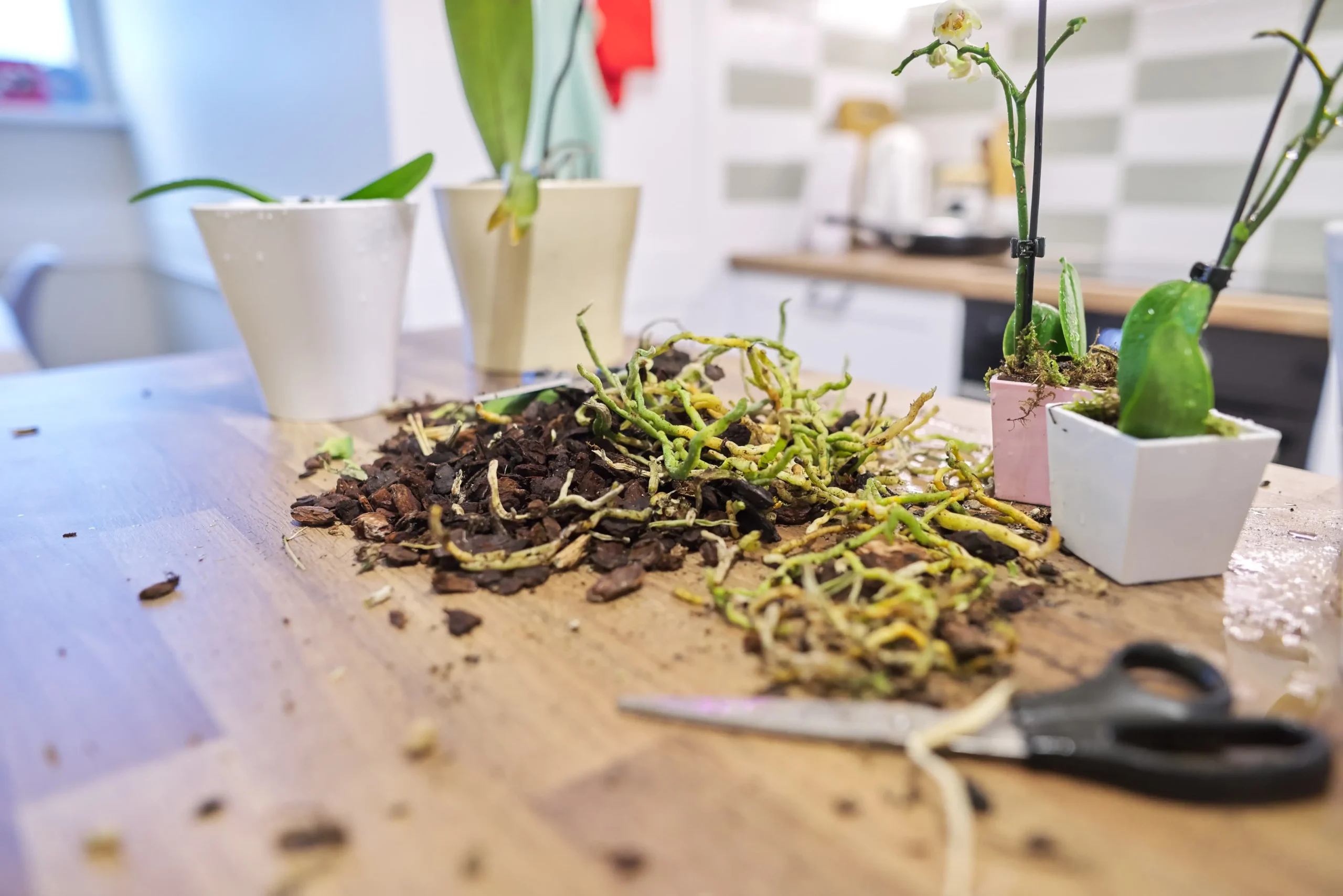Have you ever spotted a tiny plantlet forming on your orchid’s stem? That’s a keiki, a natural clone of your orchid plant.
I literally panicked when I witnessed Keikis for the first time on the orchids, as their presence indicates that your plant is stressed. But it’s hard to predict the reason behind Keiki formation, as I’ve seen them numerous times on healthy Phalaenopsis.
And now, occasionally, I even use Keiki paste to stimulate their growth. I believe I am a pro at growing orchid babies. So, let’s dive in and discuss what to do if you spot them on your orchids. I’ll discuss their safe removal, potting, care requirements and lot more!
Table of Contents
What Are Orchid Keikis?
We call them Keiki because it is the Hawaiian word for “baby”. It refers to an orchid offshoot that forms on a node along the spike or cane. A Keiki differs greatly from the new growth as it will develop its leaves and roots.
At the start, it may look like a flower spike, but later aerial roots and leaves will be visible. A monopodial orchid produces Keiki at the base of the stem, while sympodial orchids develop at the cane.
Keikis are clones identical to the mother plants and are the result of asexual propagation by mature plants. These small plantlets can be grown into a full plant, either attached to the mother plant or separately.
Some orchids, such as Dendrobium, Epidendrum, and Phalaenopsis, are naturally prone to produce more Keikis than other varieties. However, Keikis are also observed in other orchids.
Why Do Orchids Grow Keikis?
Keikis can be grown naturally or by using keiki paste. But using keiki paste won’t guarantee a keiki, as it sometimes stimulates flowers. It’s tricky to predict the reason behind keiki’s formation. So, pay attention to the conditions your orchids are living in, such as temperature, humidity, and sunlight.
Natural Propagation: Some orchids produce keikis as part of their growth cycle at the end of flowering. If the plant is growing happily and has extra energy, it will produce these clones. If an old flower spike is cut off, it will prevent new growth. However, it may stimulate keiki formation.
Induced Propagation: Keiki paste is a commercially available product that contains the growth hormone cytokinin, which can stimulate keiki development.
Sign of Stress: An unhealthy orchid may produce a Keiki as a survival mechanism. It develops a baby that protects its genes. Look for signs like wilting of leaves, root rot, discolored foliage caused by improper watering, lack of nutrients, temperature or humidity change, and low light that indicate your orchid is under stress and giving a last effort to protect its lineage by developing a Keiki.
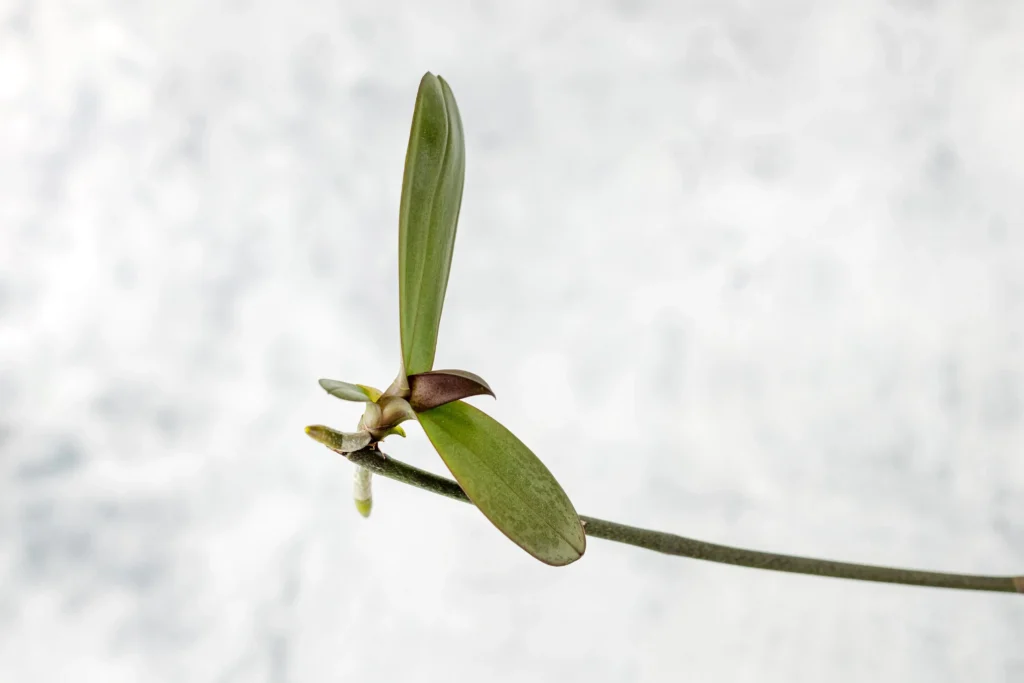
Keiki Paste: What Is It?
It’s a commercially available paste containing several growth hormones that promote cell division, growth, and differentiation. The primary ingredients are lanolin, cytokinin 6-BenzylAminoPurine (6-BAP), essential vitamins, and some preservatives.
It stimulates the formation of keikis by promoting cell division at the node. Keiki paste is effective, but sometimes, your orchid may bloom instead of a keiki. It is simple to use, water resistant, has a waxy consistency, and sometimes gives successful results.
Should You Cut Off an Orchid Keiki?
Now, back to keikis on your orchids. Knowing when to remove a Keiki from the mother plant is crucial. Timing is everything in this matter, as removing the Keiki too early or leaving it on the stressed plant will have serious consequences.
Assess the health of the parent orchid, if the plant is stressed and unhealthy a keiki on the orchid will suck additional energy. In this case, a parent orchid may not survive. I believe removing a keiki at that time is the best decision, as it will increase the chances of survival for the mother plant.
Mother plants can focus more on survival rather than providing nutrients to the baby. You can put it in a medium, and with proper care, it will develop into a mature orchid identical to its parent.
If the orchid is healthy and you believe your plant is growing a Keiki as part of the natural cycle, then leaving it on the orchid is not a bad option. However, closely observe the mother plant during Keiki growth.
Look for signs like deformed growth, unopened buds, and failed flower spikes. If you observe any of these signs, it means the plant cannot support additional Keiki growth. It is better to remove it and propagate it separately.
Types of Keikis
- On Flower Stems: A Keiki that sprouts at the base is quite different, especially when the orchid dies due to crown rot, under stress, or mainly after cutting back the old flower spike.
- Basal Keikis: Keikis that develop from the node of the flower spike or from the stem are referred to as Basal Keikis. Both types are common in Phals.
How to Remove and Pot a Keiki
In nature, a keiki has its rooting system, so it will mount on the tree while being attached to the parent plant and supporting itself. But gardeners grow keikis separately to expand their collection of orchids.
Before removing a Keiki from the mother plant, ensure it has aerial roots.
When you observe new roots on the keiki, keep it hydrated and mist it often, but don’t let the water sit on it. Patience is the key. Wait for the roots to emerge at least an inch long for successful propagation. A standard rule is that when the roots with the keikis are about 2-3 inches long along with a few leaves, plant it up.
Here are the steps I follow:
I usually wear gloves and sterilize all my tools before I encounter houseplants, as this minimizes the risk of spreading diseases. I also prepare the small pot (4 inches) and other essential tools, such as blades, cinnamon powder, and potting mix, before cutting.
- Cut the stem below the keiki, leaving a few centimeters of the spike. Remove the stem above the Keiki.
- I use cinnamon on the mother plant and Keiki’s cuts to prevent infections, as it has great fungicidal properties. You can also use an orchid fungicide.
- Place the keiki in the center of the pot so that the lower leaves are at the pot level. I advise using a small transparent pot with a sphagnum moss potting medium and evening out the substrate. It will be easy to monitor the keiki’s growth.
Another great method is to fill the base of the pot with moss and wrap it around the cane until you get a ball bigger than your pot. Tightly pot the Keiki so the moss can’t dry out easily. Tap out the moss and stabilize it in the pot.
If you are propagating multiple Keikis at the same time, place it in indirect light and label the date and genus. As the plant matures, consider some other potting mix, such as orchid mix or bark.
You can propagate it in the same container as the mother plant. The Keiki will absolutely love it because the stable soil and balanced nutrients will help it grow better. Moreover, the overall plant looks bushier as the Keiki matures and blooms.
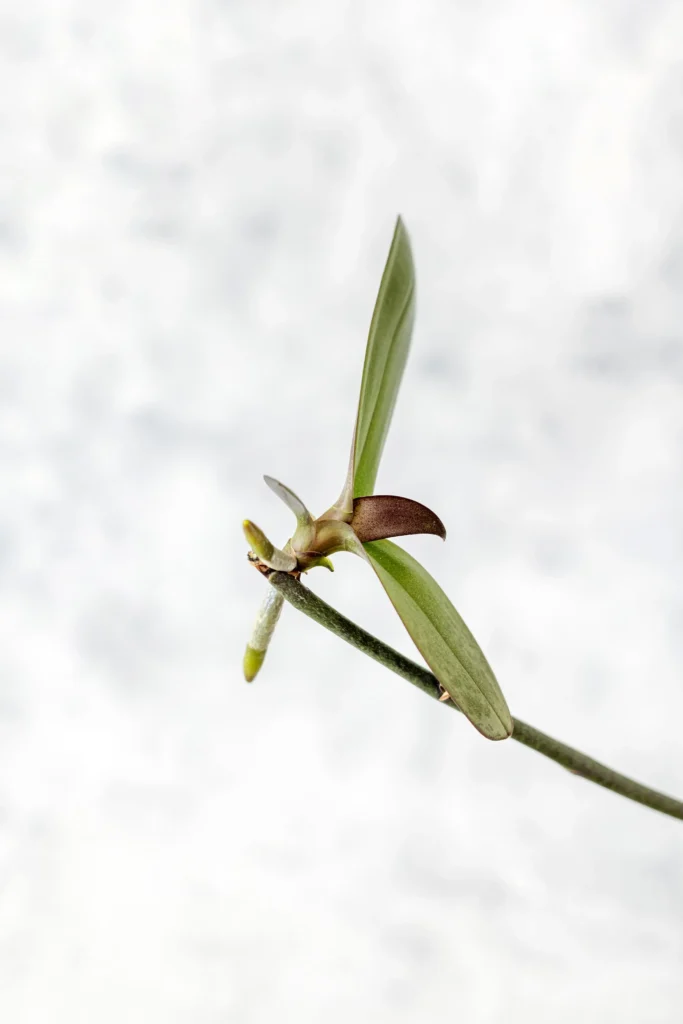
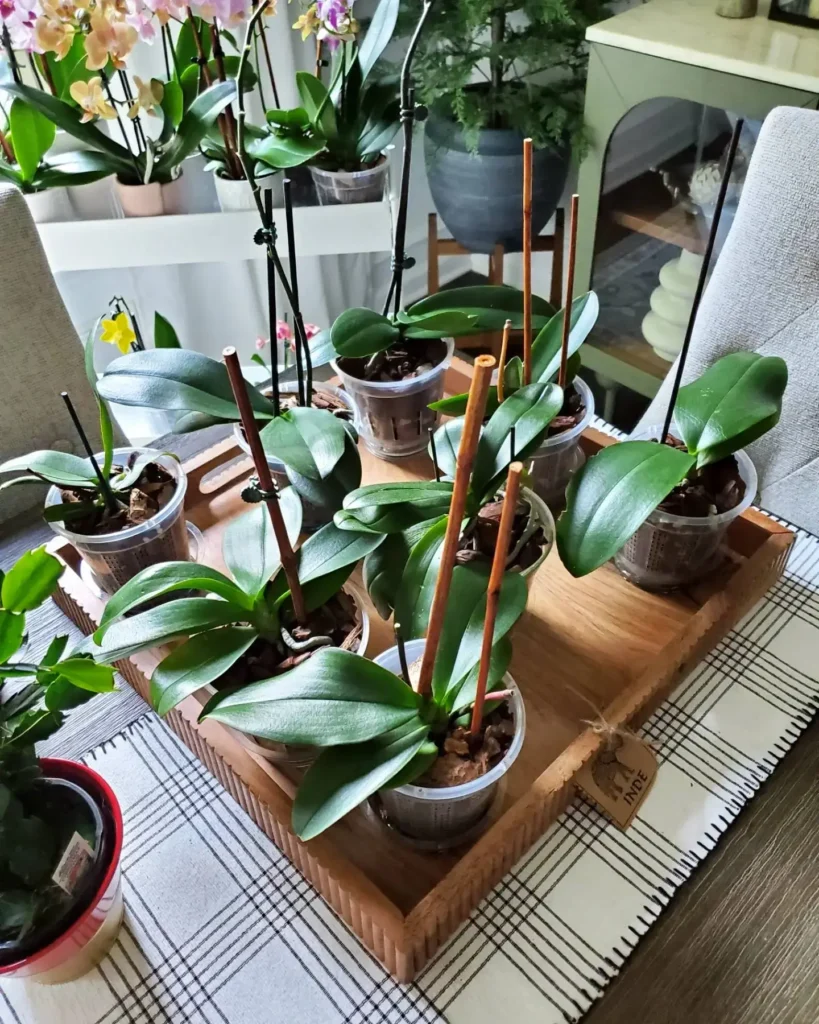
Potting Media Options
I prefer Sphagnum moss because it retains moisture well. I always pre-moist the moss before planting a Keiki, as it’s pretty difficult to wet the moss.
Other suitable media such as Orchid bark mix and cork or peat moss, are recommended for epiphytic varieties like Dendrobiums for better aeration and moisture retention.
Select the Right Container
A suitable container for propagating Keiki should have good drainage and aeration. I prefer clear plastic pots because monitoring the root health is feasible. Another good option is a clay pot that promotes good aeration, which is essential to prevent root rot.
Caring for Your Keiki
It takes about 1-2 years for a Keiki to mature fully, but you’ll observe small leaf growth with time. Keep an eye on the keiki as it is a crucial period for growth. I use a wooden skewer to provide gentle support and help it to stand upright. Moreover, following these tips will help you raise the orchid baby well.
1. Fertilizing
Avoid fertilizer in freshly propagated Keikis, as it is not essential at the initial stage of growth. Look for the signs of new leaves that show that Keiki is well-established and stable. Use a diluted orchid fertilizer in summer, when plants focus more on growth.
2. Light Exposure and Water
When propagated, do not expose the keiki to too much direct sunlight. Gradually introduce the keiki to bright but indirect light. As you observe the signs of growth, you can place the baby in the same location as the mother plant.
Keikis require slightly higher humidity than the mother plant, so place a pebble tray or humidifier near the pot. Otherwise, mist the plant. Water it weekly, do not dehydrate it, but let the medium approach dryness before watering.
3. Growth Expectations
A Keiki needs about 2 years to mature fully into a flowering plant. It grows fast if it is left attached to the mother plant because it is taking nutrients from an already established plant. To witness a successful bloom, make sure to regularly fertilize the plant, maintain optimum conditions, and check for pests.
Fun Fact: Keikis are identical to their mother, meaning they will bloom just like the original orchid, offering the same flowers.
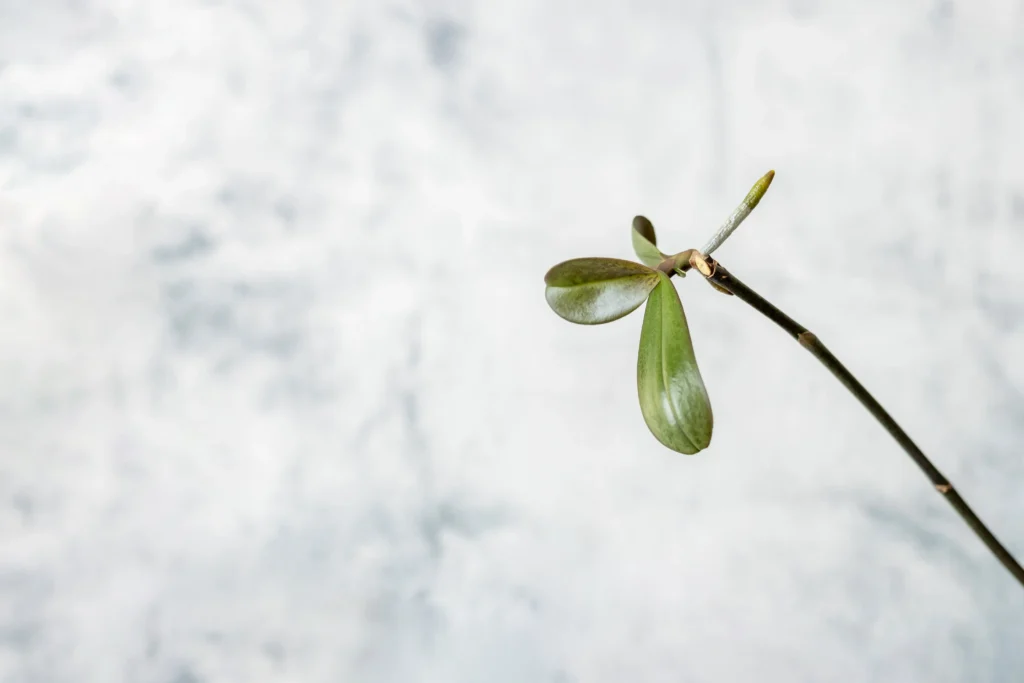
FAQs
Can I Encourage Keiki Growth with Keiki Paste?
Keiki paste is a standard solution to encourage Keikis on orchids. The paste is packed with the growth hormone cytokinin, which is essential for cell division and differentiation. Therefore, there are high chances of getting a Keiki on the orchid.
Are Orchid Keikis Rare?
No, Keikis are common on Phalaenopsis and Dendrobium, but other orchids also develop them in their lifetime. Major factors that contribute to orchid Keikis are high temperature, low light, poor watering, and stress conditions. But having a Keiki doesn’t always mean something is wrong with your orchid. Some orchids are more prone to having these babies than other varieties.
Can You Leave a Keiki on the Mother Plant?
Yes, it’s an excellent decision to leave the Keiki on the mother plant, but make sure it is not stressed or unhealthy. Because Keiki needs nutrients, taking up energy from an already stressed plant is devastating. If the mother orchid grows happily, let the Keiki grow on it.
How Often Do You Water Keiki?
Ideally, water the Keiki once a week. But if you think the substrates dry out quickly or the plant seems dehydrated, you should water it every three days. Avoid overwatering and letting the water stay on the leaves.
Summing Up
Be patient and provide your orchid proper care, and your keiki will grow from a delicate sprout into a thriving, flowering plant that mirrors its mother. Remember to choose healthy nodes for hormone treatment, wait for sturdy roots before separating your keiki, and provide gentle light, consistent moisture, and regular feeding as it establishes itself.
Follow these steps, and you’ll confidently propagate new orchids and deepen your connection to these elegant plants. Happy growing. And here’s to welcoming more “babies” into your orchid family!

